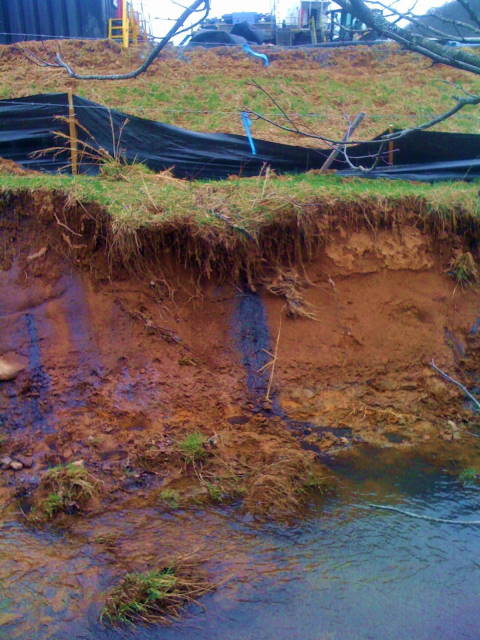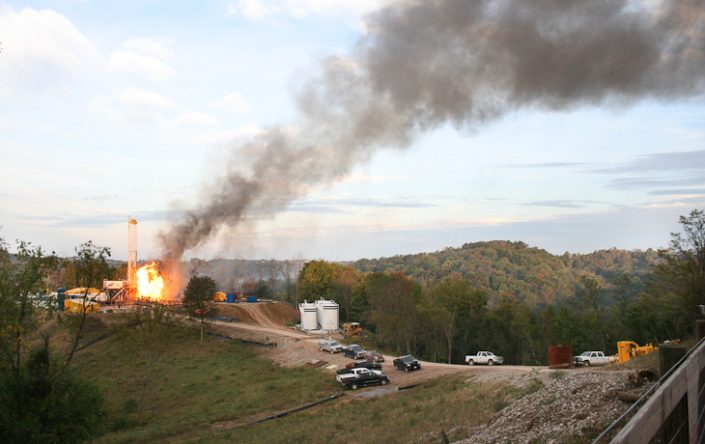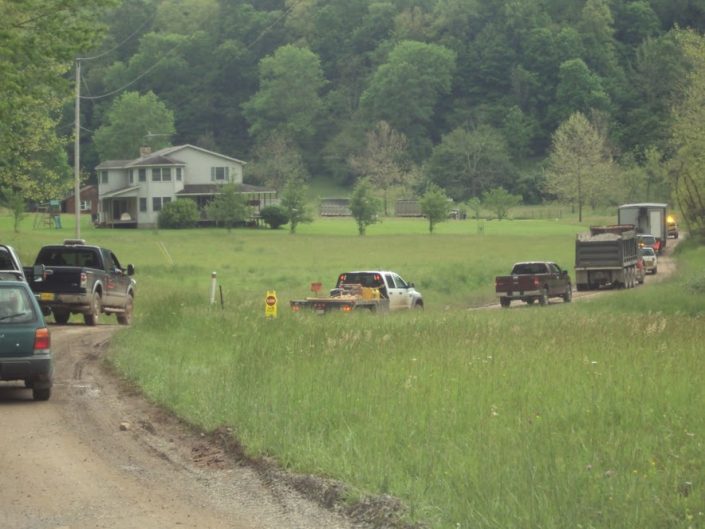Pennsylvania Oil & Gas Fines Analysis
In March 2017, FracTracker Alliance conducted a review of the available Pennsylvania oil and gas fine data released publicly by the PA Department of Environmental Protection (DEP) to identify trends in industry-related fines over time and by particular operators. In total, the DEP has assessed nearly $36 million in fines to oil and gas extraction and pipeline operators since January 1, 2000. Such fines are associated with over 42,000 violations issued1 by DEP in that time frame, covering 204,000 known oil and gas locations,2 as well as 91,000 miles of pipelines3 within the Commonwealth.
Understanding the Data Structure
The amount of money that the Pennsylvania Department of Environmental Protection (DEP) fines oil and gas (O&G) operations is included in the DEP’s compliance report published on their website. Even though fines data are made available, they are not necessarily straight-forward, and caution must be taken not to over-estimate the total number of assessed fines.
Records of fines are associated with enforcement identification codes on the compliance report. A single fine is often applied to numerous violations, and the full amount of the fine is listed on every record in this subset. Therefore, the total dollar amount of fines assessed to O&G companies appears overstated. For example, if a $400,000 fine were assessed to settle a group of 10 violations, that figure will appear on the report 10 times, for an apparent aggregate of $4,000,000 in fines. To get an accurate representation of fines assessed, we need to isolate fines associated with particular enforcement ID numbers, which are used administratively to resolve the fines.
This process is further complicated by the fact that, on occasion, such enforcement ID numbers are associated with more than one operator. This issue could result from a change in the well’s operator (or a change of the operator’s name), a group of wells in close proximity that are run by different operators, or it might point to an energy extraction company and a midstream company sharing responsibility for an incident. Sometimes, the second operator listed under an enforcement ID is in fact “not assigned.” The result is that we cannot first summarize by operator and then aggregate those subtotals without overstating the total amount of the assessed fines. In all, 62 of the enforcement ID numbers apply to more than one operator, but this figure amounts to less than one percent of the nearly 15,000 distinct enforcement ID numbers issued by DEP.
Conventional & Unconventional Violations & Fines
Oil and gas wells in Pennsylvania are categorized as either conventional or unconventional, with the latter category intended to represent the modern, industrial-scaled operations that are commonly referred to as “fracking wells.” Contrastingly, conventional wells are supposed to be the more traditional O&G wells that have been present in Pennsylvania since 1859. The actual definition of these wells leaves some blurring of this distinction, however, as almost all O&G wells now drilled in Pennsylvania are stimulated with hydraulic fracturing to some degree, and some of the conventional wells are even drilled horizontally – just not into formations that are technically defined as unconventional. For the most part, however, unconventional remains a useful distinction indicating the significant scale of operations.
Table 1. Summary of oil and gas wells, violations, and fines in Pennsylvania
| Category | Conventional | Unconventional | (blank) | Total |
| Wells | 193,655 | 10,291 | 0 | 203,946 |
| Violations | 27,223 | 6,126 | 9,026 | 42,375 |
| Fines | $7,000,203 | $13,689,032 | $21,563,722 | $35,949,495* |
| Fines per Violation | 257 | 2,235 | 2,389 | 848 |
| Fines per Well | 36 | 1330 | – | 176.27 |
| Violations per Well | 0.14 | 0.60 | – | 0.21 |
| Wells per Violation | 7.11 | 1.68 | – | 4.81 |
| * The total fine amount issued is not a summary of the three preceding categories, as some of the fines appear in multiple categories | ||||
Ninety-five (95)% of the state’s 204,000 O&G wells are classified as conventional, so it should not be surprising to see that this category of wells accounts for a majority of violations issued by the department. However, fines associated with these violations are less frequent, and often less harsh; the $7 million in fines for this category accounts for only 19% of the total assessed penalties. In contrast, the total penalties that have been assessed to unconventional wells in the state are nearly twice that of conventional wells, despite accounting for just 5% of the state’s well inventory
On the 54,412 records on the compliance report, 10,518 (19%) do not indicate whether or not it is an unconventional well. The list of operators includes some well-known conventional and unconventional drilling operators, and hundreds of names of individuals or organizations where O&G drilling is not their primary mode of business (such as municipal authorities and funeral homes). This category also contains violations for midstream operations, such as pipelines and compressor stations. Altogether, 3,795 operators have entries that were not categorized as either conventional or unconventional on the compliance report, and 124 of these operators were issued fines. One additional complication is that some of the violations and fines that fall into this category are cross-referenced in the conventional and unconventional categories, as well.
The resulting impact of these factors is that the blank category obscures the trends for violations and fines in the other two categories. While tempting to reclassify well data in this category as either conventional or unconventional, this would be a tall task due to the sheer number of records involved, and would likely result in a significant amount of errors. Therefore, the FracTracker Alliance has decided to present the data as is, along with an understanding of the complexities involved.
Most Heavily Fined Operators
Despite the numerous caveats listed above, we can get a clear look at the aggregated fines issued to the various O&G operators in the state by constructing our queries carefully. Table 2 shows the top 12 recipients of O&G-related fines assessed by DEP since 2000. Ten of these companies are on the extraction side of the business, and the total number of well permits issued4 to these companies since 2000 are included on the table. By looking at the permits instead of the drilled wells, we discover the operator that was originally associated with the drilling location, whereas the report of drilled wells associates the current operator associated with the site, or most recent operator in the event that the location is plugged and abandoned.
Stonehenge Appalachia and Williams Field Services operate in the midstream sector. Combining the various business name iterations and subsidiaries would be an enormous task, which we did not undertake here, with the exception of those near the top of the list. This includes Vantage Energy Appalachia, which was combined with records from Vantage Energy Appalachia II, and the compliance history of Rice Energy is the sum of three subsidiaries, the drilling company Rice Drilling B, and two pipeline companies, Rice Midstream Holdings and Rice Poseidon Midstream.
Table 2. Top 12 operators that have been assessed oil and gas-related fines by DEP since 2000
| Operator | Total Fines | Conventional Permits | Unconventional Permits | Violations | Fines / Violation | Fines / Permit |
| Range Resources Appalachia LLC | $5,717,994 | 2,104 | 2,206 | 819 | $6,982 | $1,327 |
| Chesapeake Appalachia LLC | $3,120,123 | 18 | 3,072 | 754 | $4,138 | $1,010 |
| Rice Energy* | $2,336,552 | 442 | 165 | $14,161 | $5,286 | |
| Alpha Shale Res LP | $1,681,725 | 3 | 62 | 31 | $54,249 | $25,873 |
| Stonehenge Appalachia LLC | $1,500,000 | – | – | 294 | $5,102 | – |
| Cabot Oil & Gas Corp | $1,407,275 | 19 | 902 | 726 | $1,938 | $1,528 |
| CNX Gas Co LLC | $1,274,330 | 1,613 | 677 | 387 | $3,293 | $556 |
| WPX Energy Appalachia LLC | $1,232,500 | 347 | 159 | $7,752 | $3,552 | |
| Chevron Appalachia LLC | $1,077,553 | 2 | 604 | 113 | $9,536 | $1,778 |
| Vantage Energy Appalachia LLC** | $1,059,766 | 3 | 300 | 35 | $30,279 | $3,498 |
| Williams Field Services Co, LLC | $872,404 | – | – | 158 | $5,522 | – |
| XTO Energy Inc | $739,712 | 1,962 | 461 | 383 | $1,931 | 305 |
| * Fines for Rice Energy here represent the sum of three subsidiaries, the drilling company Rice Drilling B, and two pipeline companies, Rice Midstream Holdings and Rice Poseidon Midstream.
** Fines for Vantage Energy Appalachia were combined with records from Vantage Energy Appalachia II. |
||||||
Predictably, many of the entries on this list are among the most active drillers in the state, including Range Resources and Chesapeake Appalachia. However, Alpha Shale Resources has the dubious distinction of leading the pack with the highest amount of fines per violation, as well as the highest amount of fines per permit. Fitting in with the theme, the story here is complicated by the fact that Alpha had a joint venture with Rice, before selling them their stake in a group of wells and midstream operations that were fined $3.5 million by DEP.5 On this compliance report, the fines from this incident are split between the two companies.
Fines Issued Over Time
It is worth taking a look at how O&G related fines have varied over time, as well (Figure 1, shown in millions of dollars). Numerous factors could contribute to changes in trends, such as the number of available DEP inspectors,6 the amount of attention being paid to the industry in the media, differing compliance strategies employed by various political administrations, or changes in practices in the field, which could in turn be impacted by significant fines issued in the past.
Figure 1. O&G Fines Issued by DEP, 2000 through 2016
The notable spike in fines issued from 2010 to 2012 corresponds with the peak of unconventional drilling in the state – 4,908 of these industrial scaled wells were drilled during those three years, amounting to 48% of all unconventional wells in PA. In contrast, only 504 unconventional wells were drilled in 2016, or around a quarter of the total for 2011. In this context, the reduction in fines since the early part of the decade seems reasonable.
The association with the number of unconventional wells falls apart a bit in the years 2013 to 2014, however. These two years saw an average of 1,293 unconventional wells drilled, but the fines issued amounted to only 35% of the 2011 total.
Considerable strides have been made in the public accessibility of oil and gas data available from the PA DEP since FracTracker started requesting and reviewing this information in 2009. Still, there are many gaps in the datasets, such as geolocation details for 10 of the 20 largest fines issued by the department. FracTracker hopes external analyses like this one will help to close such gaps and identify operators who, too, need to improve their compliance records.
References & Footnotes
- Pennsylvania Department of Environmental Protection (PA DEP) Oil and Gas (O&G) Compliance Database.
- PA DEP O&G Spud Database. Note: Starting date 1/1/1800 captures unknown spud (wells drilled) dates.
- Pipeline Hazardous Materials and Safety Administration (PHMSA) Pipeline Data Mart Reports.
- PA DEP Permits Issued Database.
- State Impact PA. (2016). Rice Energy fined $3.5 million for wellsite and pipeline violations.
- PennEnvironment Research & Policy Center. (2017). Fracking Failures 2017, Oil and Gas Industry Environmental Violations in Pennsylvania.
Oil & Gas Fines White Paper
This analysis is also available for download in a printer-friendly, white paper format:
Cover Photo by Pete Stern, Loyalsock, PA


